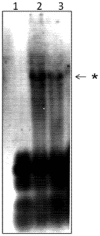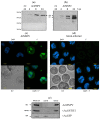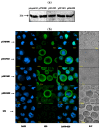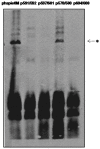Conserved structural motifs at the C-terminus of baculovirus protein IE0 are important for its functions in transactivation and supporting hr5-mediated DNA replication
- PMID: 22754648
- PMCID: PMC3386618
- DOI: 10.3390/v4050761
Conserved structural motifs at the C-terminus of baculovirus protein IE0 are important for its functions in transactivation and supporting hr5-mediated DNA replication
Abstract
IE0 and IE1 are transactivator proteins of the most studied baculovirus, the Autographa californica multiple nucleopolyhedrovirus (AcMNPV). IE0 is a 72.6 kDa protein identical to IE1 with the exception of its 54 N-terminal amino acid residues. To gain some insight about important structural motifs of IE0, we expressed the protein and C‑terminal mutants of it under the control of the Drosophila heat shock promoter and studied the transactivation and replication functions of the transiently expressed proteins. IE0 was able to promote replication of a plasmid bearing the hr5 origin of replication of AcMNPV in transient transfections with a battery of eight plasmids expressing the AcMNPV genes dnapol, helicase, lef-1, lef-2, lef-3, p35, ie-2 and lef-7. IE0 transactivated expression of the baculovirus 39K promoter. Both functions of replication and transactivation were lost after introduction of selected mutations at the basic domain II and helix-loop-helix conserved structural motifs in the C-terminus of the protein. These IE0 mutants were unable to translocate to the cell nucleus. Our results point out the important role of some structural conserved motifs to the proper functioning of IE0.
Keywords: IE0 transactivator; baculovirus; functions; mutagenesis.
Figures







Similar articles
-
Defining the roles of the baculovirus regulatory proteins IE0 and IE1 in genome replication and early gene transactivation.Virology. 2014 Nov;468-470:160-171. doi: 10.1016/j.virol.2014.07.044. Epub 2014 Aug 30. Virology. 2014. PMID: 25173193
-
The Autographa californica multiple nucleopolyhedrovirus ie0-ie1 gene complex is essential for wild-type virus replication, but either IE0 or IE1 can support virus growth.J Virol. 2005 Apr;79(8):4619-29. doi: 10.1128/JVI.79.8.4619-4629.2005. J Virol. 2005. PMID: 15795248 Free PMC article.
-
Novel regulatory properties of the IE1 and IE0 transactivators encoded by the baculovirus Autographa californica multicapsid nuclear polyhedrosis virus.J Virol. 1991 Oct;65(10):5281-8. doi: 10.1128/JVI.65.10.5281-5288.1991. J Virol. 1991. PMID: 1895384 Free PMC article.
-
Reduced expression of the immediate-early protein IE0 enables efficient replication of Autographa californica multiple nucleopolyhedrovirus in poorly permissive Spodoptera littoralis cells.J Virol. 2003 Jan;77(1):535-45. doi: 10.1128/jvi.77.1.535-545.2003. J Virol. 2003. PMID: 12477858 Free PMC article.
-
[Replication of the baculovirus genome].Mol Biol (Mosk). 2003 Mar-Apr;37(2):288-99. Mol Biol (Mosk). 2003. PMID: 12723476 Review. Russian.
Cited by
-
A Novel Transgenic Sf9 Cell Line for Quick and Easy Virus Quantification.Insects. 2024 Sep 11;15(9):686. doi: 10.3390/insects15090686. Insects. 2024. PMID: 39336654 Free PMC article.
-
Genome sequence and analysis of Buzura suppressaria nucleopolyhedrovirus: a group II Alphabaculovirus.PLoS One. 2014 Jan 24;9(1):e86450. doi: 10.1371/journal.pone.0086450. eCollection 2014. PLoS One. 2014. PMID: 24475121 Free PMC article.
-
Development of an insect cell-based adeno-associated virus packaging cell line employing advanced Rep gene expression control system.Mol Ther Methods Clin Dev. 2022 Oct 28;27:391-403. doi: 10.1016/j.omtm.2022.10.015. eCollection 2022 Dec 8. Mol Ther Methods Clin Dev. 2022. PMID: 36381303 Free PMC article.
-
Construction and characterization of a synthetic Baculovirus-inducible 39K promoter.J Biol Eng. 2018 Dec 4;12:30. doi: 10.1186/s13036-018-0121-8. eCollection 2018. J Biol Eng. 2018. PMID: 30534200 Free PMC article.
-
Significant productivity improvement of the baculovirus expression vector system by engineering a novel expression cassette.PLoS One. 2014 May 13;9(5):e96562. doi: 10.1371/journal.pone.0096562. eCollection 2014. PLoS One. 2014. PMID: 24824596 Free PMC article.
References
-
- Carson D.D., Guarino L.A., Summers M.D. Functional mapping of an AcNPV immediately early gene which augments expression of the IE-1 trans-activated 39K gene. Virology. 1988;162:444–451. - PubMed
-
- Choi J., Guarino L.A. Expression of the IE1 transactivator of Autographa californica nuclear polyhedrosis virus during viral infection. Virology. 1995;209:99–107. - PubMed
-
- Friesen P.D. Regulation of baculovirus early gene expression. In: Miller L.K., editor. The Baculoviruses. Plenum; New York, NY, USA: 1997. pp. 141–166.
-
- Huijskens I., Li L.L., Willis L.G., Theilmann D.A. Role of AcMNPV IE0 in baculovirus very late gene activation. Virology. 2004;323:120–130. - PubMed
Publication types
MeSH terms
Substances
LinkOut - more resources
Full Text Sources
Research Materials

